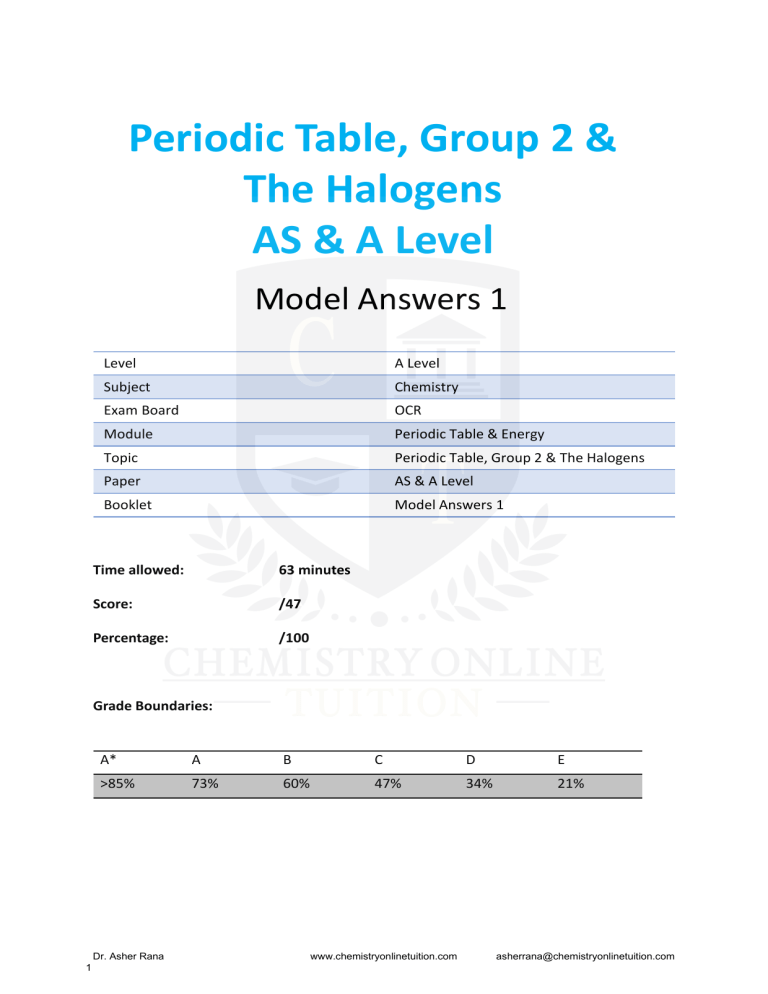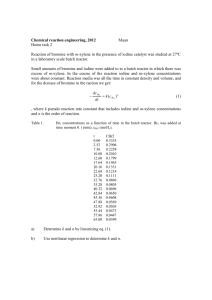
Periodic Table, Group 2 & The Halogens AS & A Level Model Answers 1 Level A Level Subject Chemistry Exam Board OCR Module Periodic Table & Energy Topic Periodic Table, Group 2 & The Halogens Paper AS & A Level Booklet Model Answers 1 Time allowed: 63 minutes Score: /47 Percentage: /100 Grade Boundaries: A* A B C D E >85% 73% 60% 47% 34% 21% Dr. Asher Rana 1 www.chemistryonlinetuition.com asherrana@chemistryonlinetuition.com Question 1 This question is about the attraction between particles. (a) State how and explain why the attraction between nuclei and outermost electrons in gaseous atoms varies across Period 3. [2] The attraction between the nuclei and outermost electrons increases across the period. This is because: • the number of protons increases (= nuclear charge increases) • the outer electrons are in the same shell, so they experience similar shielding /OR/ • the atomic radius decreases (because the outer electrons are attracted more strongly as the nuclei contain a greater number of protons) A diagram to show the trends in atomic size across the periodic table: Dr. Asher Rana 2 www.chemistryonlinetuition.com asherrana@chemistryonlinetuition.com (b) The table shows the boiling points of ammonia, fluorine and bromine Boiling point / °C ammonia, NH3 – 33 fluorine, F2 – 188 59 bromine, Br2 Explain the different boiling points of NH3, F2 and Br2. Include the names of any relevant forces and particles. In your answer you should use appropriate technical terms, spelled correctly. . NH3 It has hydrogen bonding between molecules. A hydrogen bond forms between a lone pair of electrons in an electronegative atom such as oxygen (also F and N) and the Hδ+ attached to one of those electronegative atoms in a neighbouring molecule: F2 and Br2 They both have van der Waals’ forces between molecules Comparisons • The van der Waals’ forces in Br2 are stronger than in F2 because bromine has more electrons than fluorine. • The van der Waals’ forces in Br2 are greater than hydrogen bonding in NH3, but the hydrogen bonding in NH3 is stronger than van der Waals’ forces in F2 Hydrogen Bonding Dr. Asher Rana 3 Permanent Dipoles Induced Dipoles www.chemistryonlinetuition.com [5 ] [Total 7 Marks ] asherrana@chemistryonlinetuition.com Question 2 Group 2 elements react with halogens. (a) Describe and explain the trend in reactivity of Group 2 elements with chlorine as the group is descended. In your answer you should use appropriate technical terms, spelled correctly. [5] The reactivity of group 2 elements with chlorine increases as the group is descended because: • the atomic radius increases • there are more shells, therefore more shielding • so the outermost electrons experience less attraction to the nucleus (even though the nuclear charge increases, the increased shielding outweighs this factor) Therefore, it is easier to remove the outer electrons (or in other words: the ionisation energy decreases). A diagram to show the trends in atomic radii in the periodic table: Dr. Asher Rana 4 www.chemistryonlinetuition.com asherrana@chemistryonlinetuition.com (b) A student was provided with an aqueous solution of calcium iodide. The student carried out a chemical test to show that the solution contained iodide ions. In this test, a precipitation reaction took place. (i) State the reagent that the student would need to add to the solution of calcium iodide. [1] aqueous AgNO3 (silver nitrate) (ii) What observation would show that the solution contained iodide ions? [1] yellow precipitate (iii) Write an ionic equation, including state symbols, for the reaction that took place. [1] Ag+ (aq) + I- (aq) → AgI (s) (iv) The student is provided with an aqueous solution of calcium bromide that is contaminated with calcium iodide. The student carries out the same chemical test but this time needs to add a second reagent to show that iodide ions are present. State the second reagent that the student would need to add. Concentrated NH3 (aq) Dr. Asher Rana 5 www.chemistryonlinetuition.com asherrana@chemistryonlinetuition.com [1] Explanation for part b. • AgNO3 (aq) + X- (aq) → AgX (s) + NO3- (aq) • The solid AgX has a different colour depending on the halide ion (X-) • However, in the real experiment, it is hard to differentiate between the silver halide colours, therefore ammonia solution is added to confirm the precipitate, using the following observations: X- AgX Colour of AgX (s) adding dilute NH3 Cl - AgCl white dissolves, colourless solution Br- AgBr cream insoluble I- AgI pale yellow insoluble adding concentrated NH3 dissolves, colourless solution dissolves, colourless solution insoluble [Total 9 Marks] Dr. Asher Rana 6 www.chemistryonlinetuition.com asherrana@chemistryonlinetuition.com Question 3 Periodicity is a repeating pattern across different periods. (a) First ionisation energy shows a trend across Period 2. The first ionisation energies of lithium, carbon and fluorine are shown in Table 5.1 below. Element Lithium Carbon Fluorine First ionisation energy / kJ mol–1 520 1086 1681 Table 5.1 (i) Explain the trend across Period 2 shown in Table 5.1. In your answer, you should use appropriate technical terms, spelled correctly. Across the period, • the number of protons increases, therefore there is greater nuclear charge • since they are all in the same period, the outermost electrons experience similar shielding • therefore, the outer electrons are attracted more strongly to the nucleus The general trend across a period: As the atomic number increases (i.e. number of protons increases), the first ionisation energy increases: Dr. Asher Rana 7 www.chemistryonlinetuition.com asherrana@chemistryonlinetuition.com [3] (ii) Solid carbon exists in two forms, diamond and graphite. Explain why it is unnecessary to refer to carbon as either diamond or graphite in Table 5.1 [1] The first ionisation energy of an element is the energy required to remove 1 mol of electrons from 1 mol of gaseous atoms, to form 1 mol of gaseous 1+ ions. Therefore, the structure of the carbon (whether graphite or diamond) is irrelevant, as the atoms are in the gaseous state when ionised. (b) Lithium, carbon (in the form of diamond) and fluorine have very different melting points. These differences in melting points are the result of different types of structure and different forces or bonds between the particles in the structures. Part of the table below has been filled in. Complete the table below. [6] [Total 10 Marks] Dr. Asher Rana 8 www.chemistryonlinetuition.com asherrana@chemistryonlinetuition.com Question 4 Chemists can use the Periodic Table to predict the behaviour of elements. (a) What is the name of the term used to describe the repeating patterns in the Periodic Table? [1] Periodicity (b) Melting points show a trend across a period. The table below shows the melting points of three elements in Period 3 of the Periodic Table. element aluminium silicon phosphorus melting point / °C 660 1410 44 Explain the trend shown in terms of bonding and structure. In your answer, you should use appropriate technical terms spelled correctly. • Al has metallic bonding and a giant lattice structure: Dr. Asher Rana 9 www.chemistryonlinetuition.com asherrana@chemistryonlinetuition.com [6] • Si has covalent bonding and a giant lattice structure: • P has induced dipole/van der Waals’ forces between molecules and a simple covalent structure: • Metallic bonds and covalent bonds are stronger than van der Waals’ forces (note you are NOT breaking covalent bonds when you melt phosphorus but you are when you melt silicon). • Therefore, more energy is needed to overcome bonds in Al and Si than the forces in P TIP: When a question asks you to explain something in terms of bonding and structure, always check to see that you have: Described the bonding in all substances Described the structure of all substances Compare how they affect the physical property in the question (e.g. melting point) Dr. Asher Rana 10 www.chemistryonlinetuition.com asherrana@chemistryonlinetuition.com (c) Scientists use ‘sketch graphs’ to show trends. (i) Draw a sketch graph to show the general trend in ionisation energy across Period 3. [1] Increasing straight line OR curve from Na to Ar (ii) Draw a sketch graph to show the general trend in atomic radius across Period 3. Decreasing straight line OR curve from Na to Ar [1] [Total 9 Marks] Dr. Asher Rana 11 www.chemistryonlinetuition.com asherrana@chemistryonlinetuition.com Question 5 This question is about halogens. (a) Bromine is used to extract iodine from a solution containing iodide ions. (i) Write an ionic equation for the reaction. [1] Br2 + 2I– → I2 + 2Br– Iodine is oxidised by bromine, which is more reactive. (ii) Explain why iodine is less reactive than bromine. [3] Iodine has a larger atomic radius Iodine has greater shielding / more shells Iodine has weaker / less nuclear attraction (on electron gained than bromine) Reactivity in the Group VII elements decreases as you move down the group for the reasons stated above. Iodine sits below bromine on the Periodic Table and therefore is less reactive. (b) Iodine can be used for the small-scale purification of drinking water. (i) [3] Iodine reacts with water as shown below. I2 + H2O HI + HIO Using oxidation numbers, explain why this reaction is a disproportionation. Disproportionation Oxidation AND reduction of same element/iodine OR Iodine has been oxidised and Iodine has been reduced Disproportionation reactions involve oxidation and reduction of the same species in a reaction. Dr. Asher Rana 12 www.chemistryonlinetuition.com asherrana@chemistryonlinetuition.com Oxidation from 0 to +1 in HIO Reduction from 0 to –1 in HI Focusing on the iodine in the equation: ● I2 on the LHS undergoes reduction to produce HI, where the oxidation number of the iodine goes from zero (elemental state) to -1. ● I2 on the LHS also undergoes oxidation to produce the HIO, its oxidation number goes from zero (elemental state) to +1. (ii) Chlorine is used to purify water on a large scale. State one disadvantage of using chlorine for the purification of drinking water. [1] Chlorine is toxic / poisonous OR forms halogenated hydrocarbons OR forms carcinogens / toxic compounds Dr. Asher Rana 13 www.chemistryonlinetuition.com asherrana@chemistryonlinetuition.com (c) Hydrogen reacts with chlorine to form hydrogen chloride, HCl: H2(g) + Cl2(g) ∆H = –184 kJ mol–1 2HCl(g) Table 3.1 shows bond enthalpies. Bond Bond Enthalpy/ kJ mol–1 H–H +436 Cl–Cl +243 Table 3.1 Calculate the bond enthalpy for the H–Cl bond from the information above. [2] Step Working out 1.Calculate the bond enthalpy of 2 x HCl ΔH= +436 + 243 + 184 = 863 (kJ mol-1) bonds (product formed in the equation). 2. Divide by 2 to calculate the H-Cl bond enthalpy for just one HCl molecule. ΔH = 863 2 = 431.5 (kJ mol-1) (d) ‘Enthalpy change of vaporisation’ is the enthalpy change when one mole of a substance changes from a liquid to a gas at its boiling point. (i) Write an equation, including state symbols, to represent the enthalpy change of vaporisation of bromine. Br2(l) → Br2(g) Vaporisation is the change in state from a liquid to a gas. Dr. Asher Rana 14 www.chemistryonlinetuition.com asherrana@chemistryonlinetuition.com [1] (ii) Suggest whether the enthalpy change of vaporisation of bromine is exothermic or endothermic. Explain your answer. [1] Endothermic AND energy required to overcome induced dipole–dipole forces/London forces ΔHvap is +ve and the process is endothermic for the vaporisation of bromine due to the intermolecular forces present which need to be overcome. (Total 12 marks) Dr. Asher Rana 15 www.chemistryonlinetuition.com asherrana@chemistryonlinetuition.com



